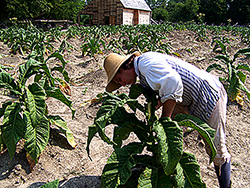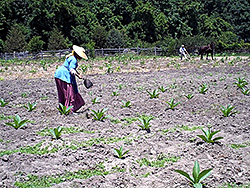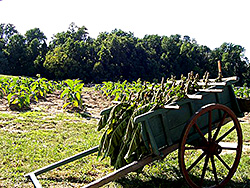Page content
Historic Farming
Tobacco
Tobacco was Virginia’s most important cash crop throughout the colonial period. It was a key element in shaping economic and social development. Tidewater Virginia’s climate and soils often were ideal for producing high quality “Sweet Scented” and “Orinoco” tobaccos.
More valuable than other crops that could be produced successfully in Virginia, tobacco was at the same time more labor intensive, with each adult worker able to produce only about one to three acres each (compared to five to 10 of cereal grains).
To prosper with commercial tobacco, one needed easily obtainable fertile soil, a minimum of tools and facilities, and workers — the most critical element. These business components had to be acquired and maintained as cheaply as possible. Workers were one’s own male children, indentured servants on contract, and male and female slaves. As the industry matured, slave labor became the most economical choice for planters to expand their labor forces. Slaves also could be applied to other production activities as well.
The tobacco year started early with the broadcast sowing of tiny seeds in “plant beds” in February and March. Four- to six-inch seedling plants were withdrawn from the beds on a wet May morning, and transplanted (or “pitched”) into small hills previously “raised” with a hilling hoe. Field plants would be carefully tended for the next two to three months while leaves grew to perfection. Each leaf would be examined twice weekly for worms and other damaging insects. Competitive weeds would be chopped and new earth drawn around the plant, in classic Native American style.
When the flower stalk emerged in June, each plant was “topped” to direct growth energy into the remaining six to 12 leaves. As the plants became ripe in August and September they were harvested by splitting each stalk and hanging six mature plants over a thin stick. This was taken to the curing house to undergo a four- to six-week curing phase. Only after this important slow-drying transformation would the leaves take on their valuable tobacco qualities.
Through the late fall and winter months, leaves would be stripped, sorted, tied into bundles of six, and packed (or “prized”) into large “hogshead” barrels weighing 900 to 1,200 pounds each. These were taken to tobacco warehouses along the rivers for inspection, issuance of receipts (crop or transfer notes), and storage until exported to England or Scotland.
By 1772, Virginia exported more than 70 million pounds of raw leaf tobacco destined for pipe, snuff, or chewing tobacco products. This represented a slowly declining portion of Virginia’s output as the agricultural-based economy was diversified to accommodate cereal grains and other farming activities. Wheat and corn would replace tobacco through most of the region by century’s end.



